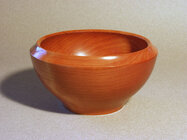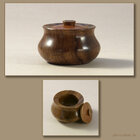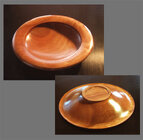I finished a vase with polymerized linseed oil, with the thought of buffing it to get more shine. I waited two weeks after putting the oil on to buff it with EEE and white diamond. I didn't get much of a shine after buffing. I'm thinking now to try a few coats of Danish Oil (oil/poly mix) on it. Anyone know if the linseed oil won't allow the poly mix to adhere to the surface? Thanks.
-
April 2025 Turning Challenge: Turn an Egg! (click here for details) -
Congratulations to Kelly Shaw winner of the March 2025 Turning Challenge (click here for details) -
Congratulations to Ellen Starr for "Lotus Temple" being selected as Turning of the Week for 21 April, 2025 (click here for details) -
Welcome new registering member. Your username must be your real First and Last name (for example: John Doe). "Screen names" and "handles" are not allowed and your registration will be deleted if you don't use your real name. Also, do not use all caps nor all lower case.
You are using an out of date browser. It may not display this or other websites correctly.
You should upgrade or use an alternative browser.
You should upgrade or use an alternative browser.
Danish Oil Over Polymerized Linseed Oil
- Thread starter Ed Weingarden
- Start date
The linseed shouldn't cause any problems. If you want a smoother surface than the wood is supporting, you can try a sander sealer. Personally when I want more shine, I turn to a higher grit, sanding sealer, linseed and finally carnauba friction heat polish. I can usually see the LEDs in the reflection at this point...
I waited two weeks after putting the oil on to buff it with EEE and white diamond. I didn't get much of a shine after buffing. I'm thinking now to try a few coats of Danish Oil (oil/poly mix) on it. Anyone know if the linseed oil won't allow the poly mix to adhere to the surface?
How many coats of linseed oil did you use? With any oil I usually apply multiple coats, let dry overnight between.
SInce "danish" oil usually is made from linseed oil, a bit of poly, and some solvent, I suspect it would adhere OK but haven't tried that myself. You could make a test on a sample piece.
I usually apply 6-10 coats of "danish" oil over a week or more. The temperature and humidity in my shop are controlled so this works well. However, I am rarely interested in a shiny/glossy finish.
Last edited:
@John K Jordan - I applied 2 coats of Linseed oil, with a few days between coats. I mix my own "Danish Oil" with equal parts of BLO, poly, and mineral spirits.
Apply, wait 20 minutes, wipe off, then dry overnight? It should build up a thin coat of layers. Maybe more applications would help. I usually do all this with just the "danish" oil. For a shiny surface, (depending on the wood) it takes a lot of coats and a couple of weeks. I let dry for at least 3 days after the last coat before buffing.@John K Jordan - I applied 2 coats of Linseed oil, with a few days between coats. I mix my own "Danish Oil" with equal parts of BLO, poly, and mineral spirits.
Note that I seldom go for a "mirror" gloss. For that I might use lacquer instead. I prefer a bit more of a gentle satin sheen.
Cherry, walnut/cherry, lyptus (got shinier on the bottom than I intended - the wood is quite hard)



Shouldn't be a problem, but I would give it a light scuff sanding with ~400x just to help with adhesion.
Yup, multiple coats, if you add a little more poly to the mix it will build faster. I dont use EEE at this stage prefer something finer, often just use a 100 leaf cotton buff with light pressure.
@John K Jordan - the type of finish that I am looking for is what I see in your photos. Thanks for the feedback, and thanks to the others for your comments/suggestions.
Before putting on any kind of surface film finish, you'll need to completely, 100%, remove every last trace of the wax from that buffing compound, or the film finish won't adhere. A thorough wipe down with mineral spirits, or remount on the lathe and sand with fine sandpaper followed by a mineral spirits wipe, then apply a very light coat, or two or three, of gloss varnish mixed 50/50 with mineral spirits, no extra oil. (Shellac and lacquer will provide high shine film surfaces, too.) Then, after the new surface film finish is completely cured, try your buffing compound again to knock down the high shine to a level that you are wanting.I finished a vase with polymerized linseed oil, with the thought of buffing it to get more shine. I waited two weeks after putting the oil on to buff it with EEE and white diamond. I didn't get much of a shine after buffing. I'm thinking now to try a few coats of Danish Oil (oil/poly mix) on it. Anyone know if the linseed oil won't allow the poly mix to adhere to the surface? Thanks.
Wax is always the last product to go on your piece, be it buffing compounds/waxes, beeswax, or carnuba, or finish blends containing wax. Carnuba is the hardest wax, and the one that will provide the highest possible, albeit temporary, shine.
I was very glad to see this thread, although my question relates to refinishing a countertop, not a turned item. We recently redid our kitchen, and installed unfinished laminated cherry countertops. In the interests of not breathing mineral spirits/VOCs for a week or more, I thought to finish the countertops with polymerized tung oil (Sutherland Welles brand). I use this tung oil on my "daily use" turnings, and have been really happy with it. I applied multiple coats - 6 or more, and everything had time to dry. 6 months later, we have significant black water marks/discoloration around the base of the faucet. I believe there has been an issue with water persisting - possibly a micro-leak - which I will be trouble shooting. In the meantime, I'm trying to figure out the best (re)-finishing approach. As with the question above, can I sand down the affected area, bleach if necessary to remove staining (oxalic acid bleach), then recoat with tung oil to get back to the original surface/color, then re-cover the affected area with polyurethane for a more durable finish in the critical zone? Will poly adhere to fully cured tung oil? Thanks in advance.
Yes, poly, or any oil-based resin varnish, will adhere to the cured tung oil. The oil has polymerized into a film itself (within and on the surface), just like the cured varnish would (although minus the resin). Do a light, fine grit sanding (180, 220, or as recommended on the poly can), then apply the poly as directed. Do note, though, that in a high use/hard use area as a kitchen countertop, the poly may need re-coating in time. This would just be another scuff sanding and re-apply a coat or two. Thin the poly up to 50/50 with mineral spirits for easy wipe-on use. Odors should decrease greatly after a couple days even if full hardness cure may take a few weeks.
Is your metal faucet in direct contact with the wood? I think cherry has tanic acids in it that could react with metals, but faucet metal is typically brass, not iron-based ferrous metals, which I think(?) are most reactive to tanic acid from woods like oak and others. Anyone else know for sure? (Brass screws are used in oak to limit black stains.) Of course just daily normal use water splashes probably don't help right there at the base of the faucet. Even if wiped up right away, a bit of moisture can hang out right at the faucet point of contact with the wood.
You may want to consider the sheen of the varnish to best match the lower sheen of the oiled surface. Gloss poly, which is usually toughest, will have the high gloss appearance unless buffed back.
Is your metal faucet in direct contact with the wood? I think cherry has tanic acids in it that could react with metals, but faucet metal is typically brass, not iron-based ferrous metals, which I think(?) are most reactive to tanic acid from woods like oak and others. Anyone else know for sure? (Brass screws are used in oak to limit black stains.) Of course just daily normal use water splashes probably don't help right there at the base of the faucet. Even if wiped up right away, a bit of moisture can hang out right at the faucet point of contact with the wood.
You may want to consider the sheen of the varnish to best match the lower sheen of the oiled surface. Gloss poly, which is usually toughest, will have the high gloss appearance unless buffed back.
If you use a polyurethane, I would suggest using a Spar (marine grade) poly. It's formulated for the exposure to water/moisture.then re-cover the affected area with polyurethane for a more durable finish in the critical zone? Will poly adhere to fully cured tung oil? Thanks in advance.
Spar is good. Spar is a "long oil" varnish meaning it has an oil/resin ratio that is more oil than resin. Just the opposite for interior-use varnish which has more resin, relatively speaking.
Wouldn't I want more resin for this? Why would relatively more oil to resin be desirable?Spar is good. Spar is a "long oil" varnish meaning it has an oil/resin ratio that is more oil than resin. Just the opposite for interior-use varnish which has more resin, relatively speaking.
Well... yeah. Spar is said to be a bit more flexible of a film finish than high solid (resin) content varnish. That's another reason spar excels outside, it can move with expanding and contracting wood more effectively. Probably explains the warning labels on interior use varnish when they don't provide an actual reason why not to use it outdoors.Wouldn't I want more resin for this? Why would relatively more oil to resin be desirable?
A couple coats of either type on your countertop will likely perform the same. Keep an eye on it and touch up as needed.
